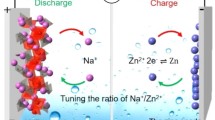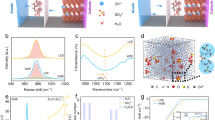Abstract
The low-cost and high-safety rechargeable zinc-ion batteries (ZIBs) show promising applications for large-scale energy storage. However, the (de)intercalation of divalent zinc ions with high charge density restricts cathode materials’ choice. Na3V2(PO4)3 (NVP) is one of the sodium (Na) super-ionic conductor materials that shows feasible utilization in aqueous ZIBs but universally has poor cycle life, commonly limited to 200 cycles or less. In this study, we investigate the capacity degradation mechanism of NVP systematically and then propose a novel organic dual-salt electrolyte to realize excellent cycling stability. We find a spontaneous dissolution of NVP when immersed in the static aqueous electrolyte, and there is an irreversible phase change during the first discharge process, leading to a fast capacity fading in aqueous electrolytes. The dissolution problem can be effectively suppressed by non-aqueous Zn2+-containing electrolytes. However, the sluggish reaction of Zn2+ intercalation into NVP causes poor reversibility. We develop a non-aqueous Na/Zn hybrid system by adding Na+ ions as charge carriers to address this issue. Highly reversible co-insertion of Na/Zn ions into the NVP enables a high capacity of 84 mA h−1 and an outstanding lifetime of 600 cycles at 500 mA g−1 without capacity loss. This work provides valuable views on the NVP’s failure mechanisms that will be helpful for ZIB development.

摘要
开发高性能正极材料是限制锌离子电池发展的重要因素. Na3V2(PO4)3 (NVP)是一种典型NASICON结构的材料, 其作为锌离 子电池正极材料具有较高的工作电压, 然而其循环性能较差, 通常 仅200圈. 本文首次系统地研究了该材料储锌性能的衰退机理. 研究 表明, 在水系电解液中NVP的自发溶解及首圈放电过程中材料的 不可逆相变是其容量衰退的主要原因. 采用含锌有机电解液虽可 避免其溶解, 但锌离子的嵌入易导致晶体结构的坍塌. 本文首次引 入钠离子作为新的载流子并构建有机Na/Zn混合离子电解液. 其 中, 两种金属离子在NVP中高度可逆的共插层反应助力Zn/Na3V2-(PO4)3电池实现了84 mA h g−1的较高容量以及在大电流密度下循 环600圈容量零衰减的高稳定性.
Similar content being viewed by others
References
Fang G, Zhou J, Pan A, et al. Recent advances in aqueous zinc-ion batteries. ACS Energy Lett, 2018, 3: 2480–2501
Tang B, Shan L, Liang S, et al. Issues and opportunities facing aqueous zinc-ion batteries. Energy Environ Sci, 2019, 12: 3288–3304
Wei T, Li Q, Yang G, et al. Pseudo-Zn-air and Zn-ion intercalation dual mechanisms to realize high-areal capacitance and long-life energy storage in aqueous Zn battery. Adv Energy Mater, 2019, 9: 1901480
Tang H, Peng Z, Wu L, et al. Vanadium-based cathode materials for rechargeable multivalent batteries: Challenges and opportunities. Electrochem Energ Rev, 2018, 1: 169–199
Lang J, Jiang C, Fang Y, et al. Room-temperature rechargeable Ca-ion based hybrid batteries with high rate capability and long-term cycling life. Adv Energy Mater, 2019, 9: 1901099
Shakourian-Fard M, Kamath G, Taimoory SM, et al. Calcium-ion batteries: Identifying ideal electrolytes for next-generation energy storage using computational analysis. J Phys Chem C, 2019, 123: 15885–15896
Li B, Masse R, Liu C, et al. Kinetic surface control for improved magnesium-electrolyte interfaces for magnesium ion batteries. Energy Storage Mater, 2019, 22: 96–104
Konarov A, Voronina N, Jo JH, et al. Present and future perspective on electrode materials for rechargeable zinc-ion batteries. ACS Energy Lett, 2018, 3: 2620–2640
Song M, Tan H, Chao D, et al. Recent advances in Zn-ion batteries. Adv Funct Mater, 2018, 28: 1802564
Kundu D, Adams BD, Duffort V, et al. A high-capacity and longlife aqueous rechargeable zinc battery using a metal oxide intercalation cathode. Nat Energy, 2016, 1: 16119
Yang G, Wei T, Wang C. Self-healing lamellar structure boosts highly stable zinc-storage property of bilayered vanadium oxides. ACS Appl Mater Interfaces, 2018, 10: 35079–35089
Hu P, Zhu T, Wang X, et al. Highly durable Na2V6O16·1.63H2O nanowire cathode for aqueous zinc-ion battery. Nano Lett, 2018, 18: 1758–1763
Hu P, Yan M, Zhu T, et al. Zn/V2O5 aqueous hybrid-ion battery with high voltage platform and long cycle life. ACS Appl Mater Interfaces, 2017, 9: 42717–42722
Chen Q, Jin J, Kou Z, et al. Zn2+ pre-intercalation stabilizes the tunnel structure of MnO2 nanowires and enables zinc-ion hybrid supercapacitor of battery-level energy density. Small, 2020, 16: 2000091
Ding J, Du Z, Gu L, et al. Ultrafast Zn2+ intercalation and dein-tercalation in vanadium dioxide. Adv Mater, 2018, 30: 1800762
Liao M, Wang J, Ye L, et al. A deep-cycle aqueous zinc-ion battery containing an oxygen-deficient vanadium oxide cathode. Angew Chem Int Ed, 2020, 59: 2273–2278
Liu R, Liu H, Sheng T, et al. Novel 3.9 V layered Na3V3(PO4)4 cathode material for sodium ion batteries. ACS Appl Energy Mater, 2018, 1: 3603–3606
Guo JZ, Wu XL, Wan F, et al. A superior Na3V2(PO4)3-based nanocomposite enhanced by both N-doped coating carbon and graphene as the cathode for sodium-ion batteries. Chem Eur J, 2015, 21: 17371–17378
Saravanan K, Mason CW, Rudola A, et al. The first report on excellent cycling stability and superior rate capability of Na3V2-(PO4)3 for sodium ion batteries. Adv Energy Mater, 2013, 3: 444–450
Zhao HB, Hu CJ, Cheng HW, et al. Novel rechargeable M3V2-(PO4)3//zinc (M = Li, Na) hybrid aqueous batteries with excellent cycling performance. Sci Rep, 2016, 6: 25809
Ming J, Guo J, Xia C, et al. Zinc-ion batteries: Materials, mechanisms, and applications. Mater Sci Eng-R-Rep, 2019, 135: 58–84
Li G, Yang Z, Jiang Y, et al. Towards polyvalent ion batteries: A zinc-ion battery based on NASICON structured Na3V2(PO4)3. Nano Energy, 2016, 25: 211–217
Li G, Yang Z, Jiang Y, et al. Hybrid aqueous battery based on Na3V2(PO4)3/C cathode and zinc anode for potential large-scale energy storage. J Power Sources, 2016, 308: 52–57
Hu P, Zhu T, Wang X, et al. Aqueous Zn//Zn(CF3SO3)2//Na3V2-(PO4)3 batteries with simultaneous Zn2+/Na+ intercalation/de-intercalation. Nano Energy, 2019, 58: 492–498
Zhang X, Ma J, Hu P, et al. An insight into failure mechanism of NASICON-structured Na3V2(PO4)3 in hybrid aqueous rechargeable battery. J Energy Chem, 2019, 32: 1–7
Li W, Wang K, Cheng S, et al. A long-life aqueous Zn-ion battery based on Na3V2(PO4)2F3 cathode. Energy Storage Mater, 2018, 15: 14–21
Hung TF, Cheng WJ, Chang WS, et al. Ascorbic acid-assisted synthesis of mesoporous sodium vanadium phosphate nanoparticles with highly sp2-coordinated carbon coatings as efficient cathode materials for rechargeable sodium-ion batteries. Chem Eur J, 2016, 22: 10620–10626
Duan W, Zhu Z, Li H, et al. Na3V2(PO4)3@C core-shell nanocomposites for rechargeable sodium-ion batteries. J Mater Chem A, 2014, 2: 8668–8675
Hu P, Zou Z, Sun X, et al. Uncovering the potential of M1-site-activated NASICON cathodes for Zn-ion batteries. Adv Mater, 2020, 32: 1907526
Jiang Y, Yang Z, Li W, et al. Nanoconfined carbon-coated Na3V2-(PO4)3 particles in mesoporous carbon enabling ultralong cycle life for sodium-ion batteries. Adv Energy Mater, 2015, 5: 1402104
Islam S, Alfaruqi MH, Putro DY, et al. Pyrosynthesis of Na3V2-(PO4)3@C cathodes for safe and low-cost aqueous hybrid batteries. ChemSusChem, 2018, 11: 2239–2247
Kundu D, Hosseini Vajargah S, Wan L, et al. Aqueous vs. non-aqueous Zn-ion batteries: Consequences of the desolvation penalty at the interface. Energy Environ Sci, 2018, 11: 881–892
Yan M, He P, Chen Y, et al. Water-lubricated intercalation in V2O5nH2O for high-capacity and high-rate aqueous rechargeable zinc batteries. Adv Mater, 2018, 30: 1703725
Li Q, Liu Y, Ma K, et al. In situ Ag nanoparticles reinforced pseudo-Zn-air reaction boosting Ag2V4O11 as high-performance cathode material for aqueous zinc-ion batteries. Small Methods, 2019, 3: 1900637
Wang L, Huang KW, Chen J, et al. Ultralong cycle stability of aqueous zinc-ion batteries with zinc vanadium oxide cathodes. Sci Adv, 2019, 5: eaax4279
Acknowledgements
This work was supported by the National Natural Science Foundation of China (91963210, U1801255, and 51872340) and the Fundamental Research Funds for the Central Universities, China (18lgpy06).
Author information
Authors and Affiliations
Contributions
Wang C and Yang G designed this work; Li Q synthesized the materials and carried out the electrochemical experiments; Li Q performed the ex-situ XRD measurements with Ma K and Hong C; Wang C, Yang G, and Li Q wrote the paper. All the authors participated in the analysis of experimental data and discussions of the results.
Corresponding authors
Additional information
Conflict of interest
The authors declare that they have no conflict of interest.
Qian Li received his BS degree from the School of Minerals Processing and Bioengineering at Central South University in 2017. Now he is pursuing his PhD under the direction of Prof. Chengxin Wang in the School of Materials Science and Engineering at Sun Yat-sen University (SYSU). His current research focuses on rechargeable zinc-ion batteries.
Gongzheng Yang is an associate professor at the School of Materials Science and Engineering, SYSU. He received his PhD degree from SYSU in 2014. He carried out his postdoctoral research in the laboratory of Prof. Chengxin Wang in SYSU. Currently, his research interest includes energy-storage materials and devices.
Chengxin Wang is a professor in the School of Materials Science and Engineering at SYSU. Dr. Wang’s research interest lies in both theoretical and experimental investigations on the nanomaterials of IV main group elements and related compounds. His current research focuses on nano energy materials.
Supporting Information
40843_2020_1550_MOESM1_ESM.pdf
Realizing excellent cycle stability of Zn/Na3V2(PO4)3 batteries by suppressing dissolution and structural degradation in non-aqueous Na/Zn dual-salt electrolytes
Rights and permissions
About this article
Cite this article
Li, Q., Ma, K., Hong, C. et al. Realizing excellent cycle stability of Zn/Na3V2(PO4)3 batteries by suppressing dissolution and structural degradation in non-aqueous Na/Zn dual-salt electrolytes. Sci. China Mater. 64, 1386–1395 (2021). https://doi.org/10.1007/s40843-020-1550-2
Received:
Accepted:
Published:
Issue Date:
DOI: https://doi.org/10.1007/s40843-020-1550-2




